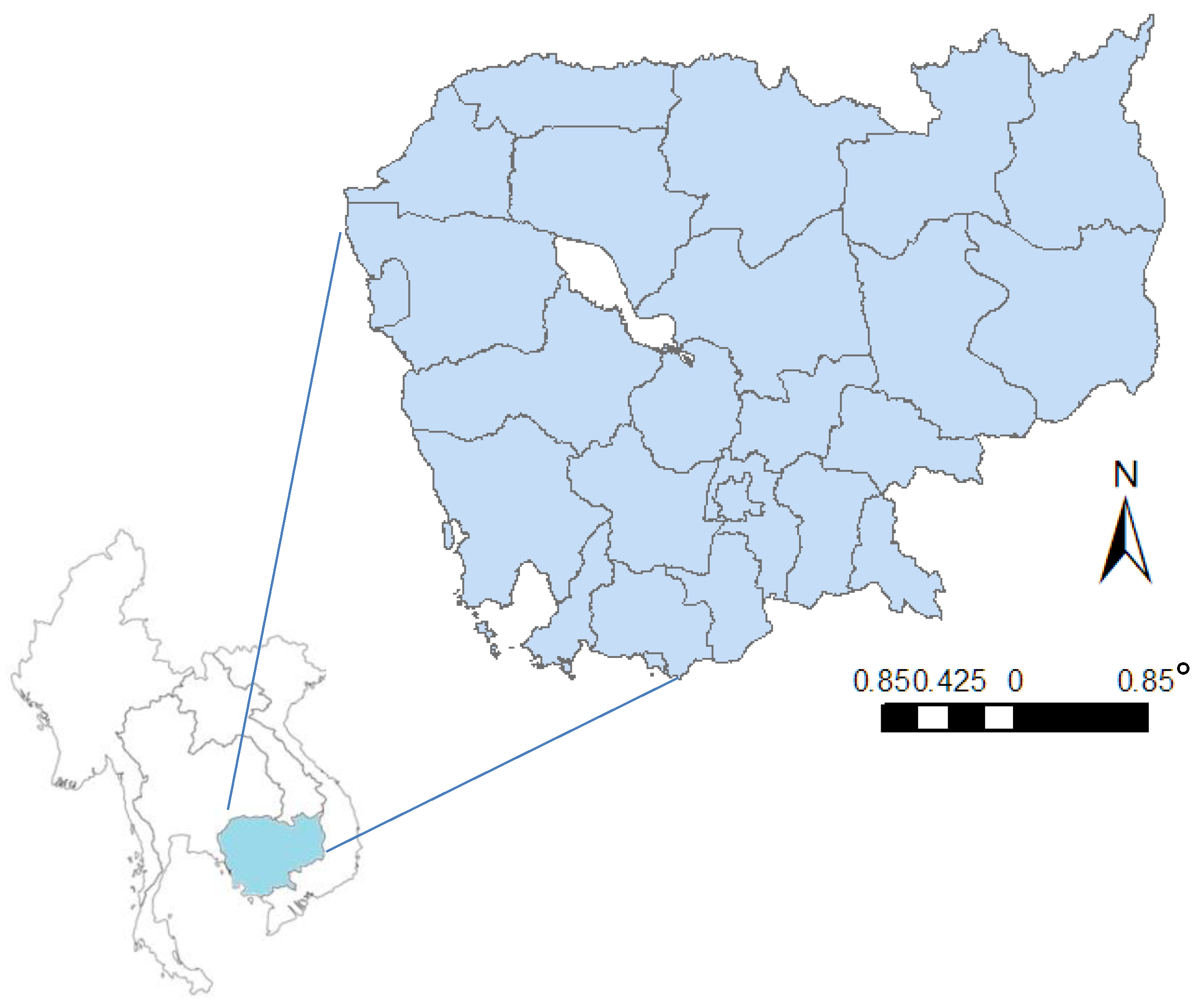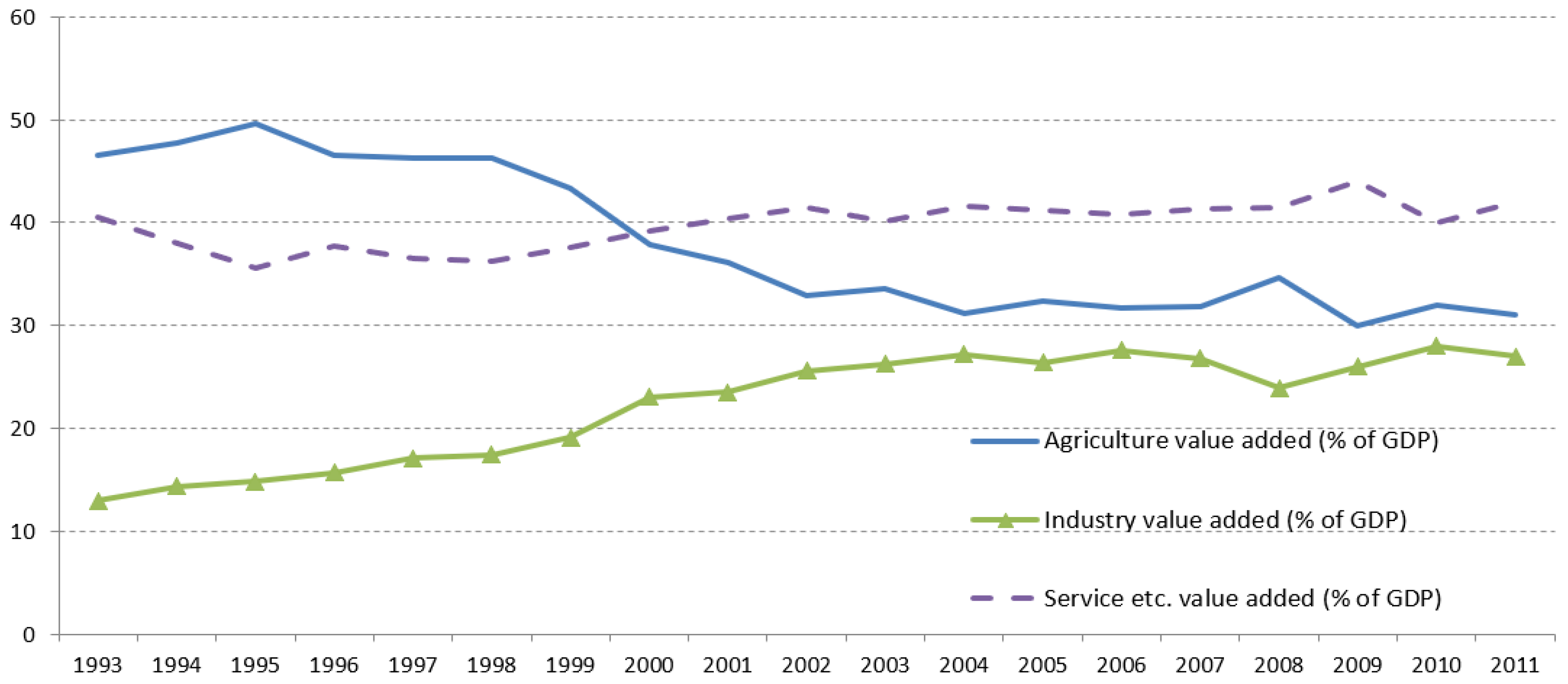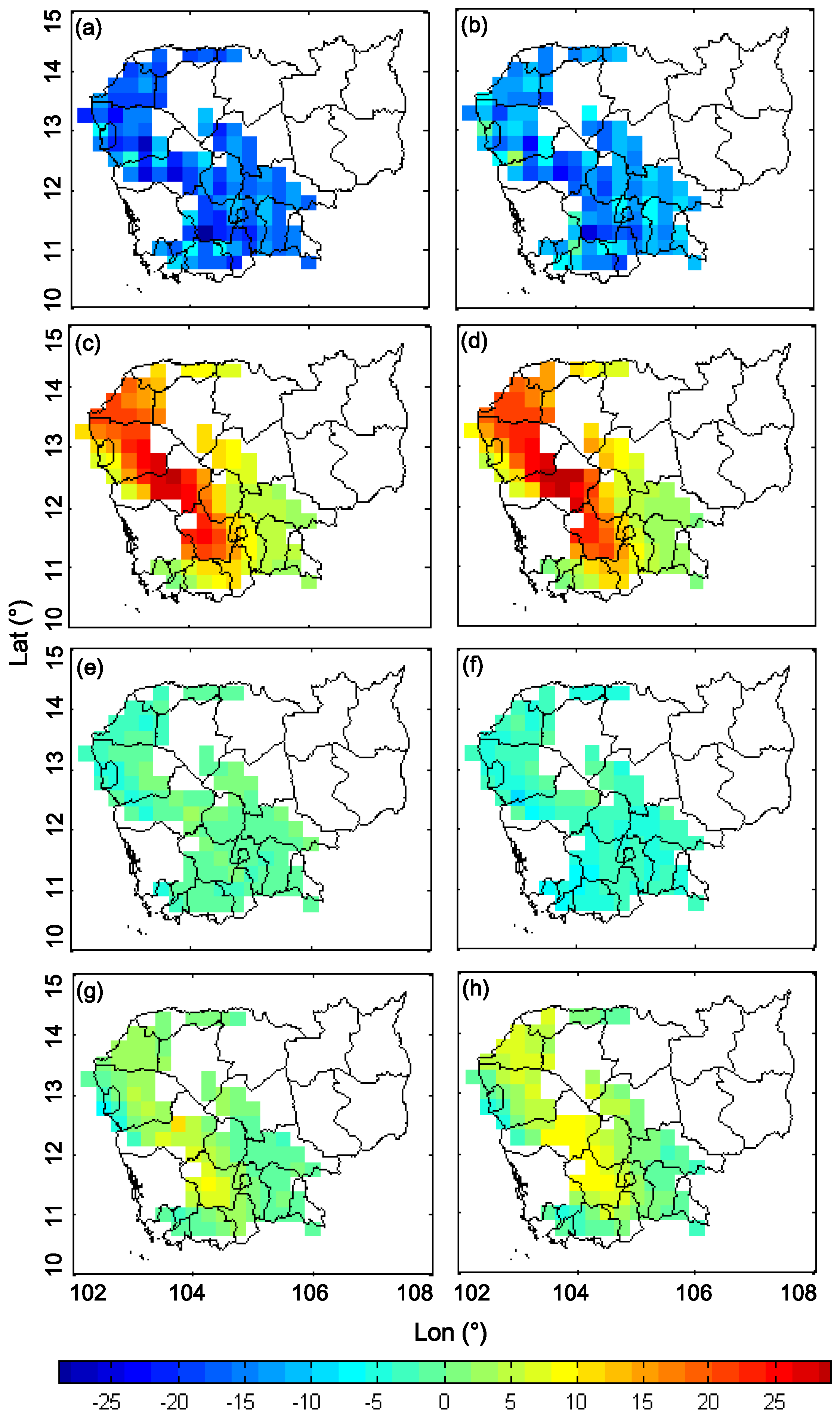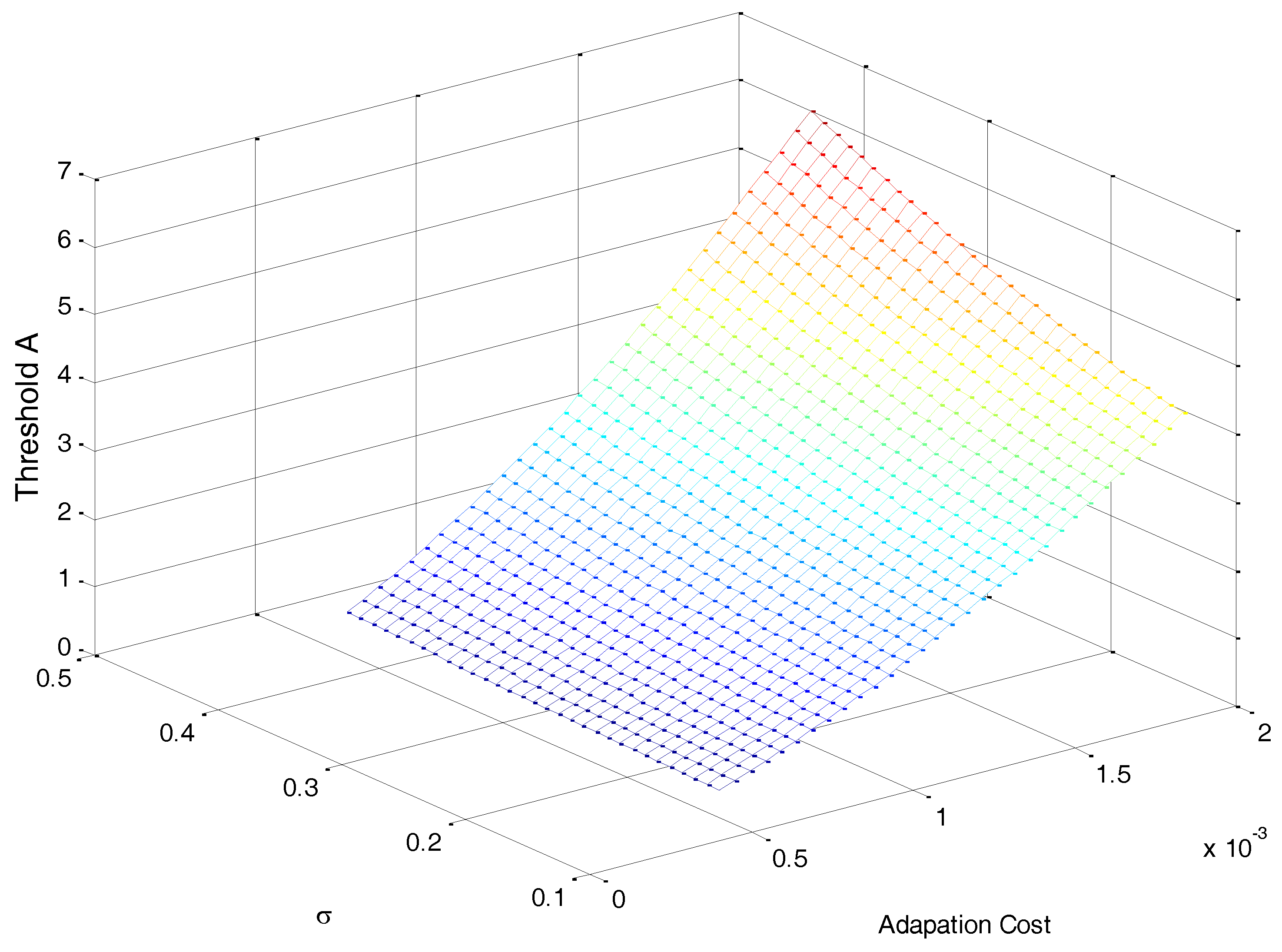Adaptation Strategies under Climate Change for Sustainable Agricultural Productivity in Cambodia
Abstract
1. Introduction
2. Methods and Data
2.1. Study Location and Data Collection
2.2. GLAM-Rice Model
2.3. Investment Model: Real Options Framework
3. Results
4. Discussion
5. Conclusions
Author Contributions
Funding
Conflicts of Interest
Appendix A. Real Options Analysis: Derivation of Equations (2) and (3)
References
- Dessler, A.E. Introduction to Modern Climate Change; Cambridge University Press: New York, NY, USA, 2011; ISBN 978-1-107-00189-3. [Google Scholar]
- Intergovernmental Panel on Climate Change (IPCC). Climate Change 2014: Impacts, Adaptation, and Vulnerability. Part A: Global and Sectoral Aspects; Contribution of Working Group II to the Fifth Assessment Report of the Intergovernmental Panel on Climate Change; Cambridge University Press: New York, NY, USA, 2014. [Google Scholar]
- Amin, M.R.; Zhang, J.; Yang, M. Effects of climate change on the yield and cropping area of major food crops: A case of Bangladesh. Sustainability 2015, 7, 898–915. [Google Scholar] [CrossRef]
- Chowdhury, I.; Earshad, K.M.A. The Impact of Climate Change on rice yield in Bangladesh: A time series analysis. Russ. J. Agric. Soc.-Econ. Sci. 2015, 40, 12–28. [Google Scholar] [CrossRef]
- Sarker, M.A.R.; Alam, K.; Gow, J. Assessing the effects of climate change on rice yields: An econometric investigation using Bangladeshi panel data. Econ. Anal. Policy 2014, 44, 405–416. [Google Scholar] [CrossRef]
- Chen, C.; Wang, E.; Yu, Q.; Zhang, Y. Quantifying the effects of climate trends in the past 43 years (1961–2003) on crop growth and water demand in the North China Plain. Clim. Chang. 2010, 100, 559–578. [Google Scholar] [CrossRef]
- Tao, F.; Zhang, Z.; Zhang, S.; Zhu, Z.; Shi, W. Response of crop yields to climate trends since 1980 in China. Clim. Res. 2012, 54, 233–247. [Google Scholar] [CrossRef]
- Wang, J.; Mendelsohn, R.; Dinar, A.; Huang, J.; Rozelle, S.; Zhang, L. The impact of climate change on China’s agriculture. Agric. Econ. 2009, 40, 323–337. [Google Scholar] [CrossRef]
- You, L.; Rosegrant, M.; Wood, S.; Sun, D. Impact of growing season temperature on wheat productivity in China. Agric. For. Meteorol. 2009, 149, 1009–1014. [Google Scholar] [CrossRef]
- Auffhammer, M.; Ramanathan, V.; Vincent, J.R. Climate change, the monsoon, and rice yield in India. Clim. Chang. 2012, 111, 411–424. [Google Scholar] [CrossRef]
- Farook, A.J.; Kannan, K.S. Climate change impact on rice yield in India: Vector autoregression approach. Sri Lankan J. Appl. Stat. 2016, 16, 161–174. [Google Scholar] [CrossRef]
- Kumar, K.K.; Kumar, K.R.; Ashrit, R.G.; Deshpande, N.R.; Hansen, J.W. Climate impacts on Indian agriculture. Int. J. Climatol. 2004, 24, 1375–1393. [Google Scholar] [CrossRef]
- Lal, M.; Singh, K.K.; Rathore, L.S.; Srinivasan, G.; Saseendran, S.A. Vulnerability of rice and wheat yields in NW India to future changes in climate. Agric. For. Meteorol. 1998, 89, 101–114. [Google Scholar] [CrossRef]
- Pathak, H.; Ladha, J.K.; Aggarwal, P.K.; Peng, S.; Das, S.; Singh, Y.; Singh, B.; Kamra, S.K.; Mishra, B.; Sastri, A.S.R.A.S.; et al. Trends of climatic potential and on-farm yields of rice and wheat in the Indo-Gangetic Plains. Field Crop Res. 2003, 80, 223–234. [Google Scholar] [CrossRef]
- Rahman, M.A.; Saboor, A.; Baig, I.A.; Shakoor, U.; Kanwal, H. An investigation of the impact of climate change on rice crop in Pakistan: A multivariate analysis. Pak. J. Agric. Sci. 2017, 54, 561–566. [Google Scholar] [CrossRef]
- Ali, S.; Liu, Y.; Ishaq, M.; Shah, T.; Abdullah; Ilyas, A.; Din, I.U. Climate change and its impact on the yield of major food crops: Evidence from Pakistan. Foods 2017, 6, 39. [Google Scholar] [CrossRef]
- Lansigan, F.P.; de los Santos, W.L.; Coladilla, J.O. Agronomic impacts of climate variability on rice production in the Philippines. Agric. Ecosyst. Environ. 2000, 82, 129–137. [Google Scholar] [CrossRef]
- Kurukulasuriya, P.; Ajwad, M.I. Application of the Ricardian technique to estimate the impact of climate change on smallholder farming in Sri Lanka. Clim. Chang. 2007, 81, 39–59. [Google Scholar] [CrossRef]
- Arunrat, N.; Pumijumnong, N. The preliminary study of climate change impact on rice production and economic in Thailand. Asian Soc. Sci. 2015, 11, 275–294. [Google Scholar] [CrossRef]
- Babel, M.S.; Agarwal, A.; Swain, D.K.; Herath, S. Evaluation of climate change impacts and adaptation measures for rice cultivation in Northeast Thailand. Clim. Res. 2011, 46, 137–146. [Google Scholar] [CrossRef]
- Boonwichai, S.; Shrestha, S.; Babel, M.S.; Weesakul, S.; Datta, A. Evaluation of climate change impacts and adaptation strategies on rainfed rice production in Songkhram River Basin, Thailand. Sci. Total Environ. 2019, 652, 189–201. [Google Scholar] [CrossRef] [PubMed]
- Lobell, D.B.; Ortiz-Monasterio, J.I.; Asner, G.P.; Matson, P.A.; Naylor, R.L.; Falcon, W.P. Analysis of wheat yield and climatic trends in Mexico. Field Crop Res. 2005, 94, 250–256. [Google Scholar] [CrossRef]
- Moula, E.L. An Empirical assessment of the impact of climate change on smallholder agriculture in Cameroon. Glob. Planet. Chang. 2009, 67, 205–208. [Google Scholar] [CrossRef]
- Deressa, T.T.; Hassan, R.M. Economic impact of climate change on crop production in Ethiopia: Evidence from cross-section measures. J. Afr. Econ. 2009, 18, 529–554. [Google Scholar] [CrossRef]
- Kabubo-Mariara, J.; Karanja, F.K. The economic impact of climate change on Kenyan crop agriculture: A Ricardian approach. Glob. Planet. Chang. 2007, 57, 319–330. [Google Scholar] [CrossRef]
- Coster, A.S.; Adeoti, A.I. Economic effects of climate change on maize production and farmers’ adaptation strategies in Nigeria: A Ricardian approach. J. Agric. Sci. 2015, 7, 67–84. [Google Scholar] [CrossRef]
- Lobell, D.B.; Burke, M.B.; Tebaldi, C.; Mastrandrea, M.D.; Falcon, W.P.; Naylor, R.L. Prioritizing climate change adaptation needs for food security in 2030. Science 2008, 319, 607–610. [Google Scholar] [CrossRef] [PubMed]
- Schlenker, W.; Lobell, D.B. Robust negative impacts of climate change on African agriculture. Environ. Res. Lett. 2010, 5, 1–8. [Google Scholar] [CrossRef]
- Butt, T.A.; McCarl, B.A.; Angerer, J.; Dyke, P.T.; Stuth, J.W. The economic and food security implications of climate change in Mali. Clim. Chang. 2005, 68, 355–378. [Google Scholar] [CrossRef]
- World Bank. The Cost to Developing Countries of Adapting to Climate Change: New Methods and Estimates; The Global Report of the Economics of Adaptation to Climate Change Study, Consultation Draft; World Bank: Washington, DC, USA, 2010. [Google Scholar]
- De Perthuis, C. Economic Choices in a Warming World; Cambridge University Press: New York, NY, USA, 2011; ISBN 978-1-107-00256-2. [Google Scholar]
- Acemoglu, D. Introduction to Modern Economic Growth; Princeton University Press: Princeton, NJ, USA, 2009; ISBN 978-0-691-13292-1. [Google Scholar]
- Gollin, D.; Parente, S.; Rogerson, R. The role of agriculture in development. Am. Econ. Rev. 2002, 92, 160–164. [Google Scholar] [CrossRef]
- Thomas, T.S.; Ponlok, T.; Bansok, R.; De Lopez, T.; Chiang, C.; Phirun, N.; Chhun, C. Cambodian Agriculture: Adaptation to Climate Change Impact, IFPRI Discussion Paper 01285; International Food Policy Research Institute: Washington, DC, USA, 2013. [Google Scholar]
- Chhinh, N. Drought, Drought Vulnerability and Adaptation Policy in Cambodia with Reference to the Farming Sector; Flinders University of South Australia: Adelaide, Australia, 2015. [Google Scholar]
- Blanc, E.; Reilly, J. Approaches to assessing climate change impacts on agriculture: An overview of the debate. Rev. Environ. Econ. Policy 2017, 11, 247–257. [Google Scholar] [CrossRef]
- Blanc, E.; Schlenker, W. The use of panel models in assessments of climate impacts on agriculture. Rev. Environ. Econ. Policy 2017, 11, 258–279. [Google Scholar] [CrossRef]
- Mendelsohn, R.O.; Massetti, E. The use of cross sectional analysis to measure climate impacts on agriculture: Theory and evidence. Rev. Environ. Econ. Policy 2017, 11, 280–298. [Google Scholar] [CrossRef]
- Antle, J.M.; Stöckle, C.O. Climate impacts on agriculture: Insights from agronomic-economic analysis. Rev. Environ. Econ. Policy 2017, 11, 299–318. [Google Scholar] [CrossRef]
- Schlenker, W.; Roberts, M.J. Nonlinear temperature effects indicate severe damages to U.S. crop yields under climate change. Proc. Natl. Acad. Sci. USA 2009, 106, 15594–15598. [Google Scholar] [CrossRef] [PubMed]
- Schlenker, W.; Roberts, M.J.; Lobell, D.B. US maize adaptability. Nat. Clim. Chang. 2013, 3, 690–691. [Google Scholar] [CrossRef]
- Berry, S.; Roberts, M.J.; Schlenker, W. Corn production shocks in 2012 and beyond: Implications for harvest volatility. In The Economics of Food Price Volatility; Chavas, J.-P., Hummels, D., Wright, B.D., Eds.; Chicago University Press: Chicago, IL, USA, 2014; pp. 59–90. ISBN 978-0-226-12892-4. [Google Scholar]
- Mendelsohn, R.; Nordhaus, W.; Shaw, D. The impact of global warming on agriculture: A Ricardian analysis. Am. Econ. Rev. 1994, 84, 753–771. [Google Scholar]
- Massetti, E.; Mendelsohn, R. The impact of climate change on US agriculture: A cross-section, multi-period, Ricardian analysis. In Handbook on Climate Change and Agriculture; Dinar, A., Mendelsohn, R., Eds.; Edward Elgar: Cheltenham, UK, 2012; pp. 141–167. ISBN 978-1-781-00194-3. [Google Scholar]
- Moore, F.; Lobell, D. Adaptation potential of European agriculture in response to climate change. Nat. Clim. Chang. 2014, 4, 610–614. [Google Scholar] [CrossRef]
- Van Passel, S.; Massetti, E.; Mendelsohn, R. A Ricardian analysis of the impact of climate change on European agriculture. Environ. Resour. Econ. 2017, 67, 725–760. [Google Scholar] [CrossRef]
- Ricardo, D. On the Principles of Political Economy and Taxation, 3rd ed.; John Murray: London, UK, 1817. [Google Scholar]
- Fischer, G.; Shah, M.; Tubiello, F.M.; van Velhuizen, H. Socio-economic and climate change impacts on agriculture: An integrated assessment, 1990–2080. Philos. Trans. R. Soc. B 2005, 360, 2067–2083. [Google Scholar] [CrossRef]
- Rosenzweig, C.; Jones, J.W.; Hatfield, J.L.; Ruane, A.C.; Boote, K.J.; Thorburn, P.; Antle, J.M.; Nelson, G.C.; Porter, C.; Janssen, S.; et al. The agricultural model intercomparison and improvement project (AgMIP): Protocols and pilot studies. Agric. For. Meteorol. 2013, 170, 166–182. [Google Scholar] [CrossRef]
- Ewert, F.; Roetter, R.P.; Bindi, M.; Webber, H.; Trnka, M.; Kersebaum, K.C.; Olesen, J.E.; van Ittersum, M.K.; Janssen, S.; Rivington, M.; et al. Crop modelling for integrated assessment of risk to food production from climate change. Environ. Model. Softw. 2015, 72, 287–303. [Google Scholar] [CrossRef]
- Antle, J.M.; Valdivia, R.O.; Boote, K.J.; Janssen, S.; Jones, J.W.; Porter, C.H.; Rosenzweig, C.; Ruane, A.C.; Thorburn, P.J. AgMIP’s transdisciplinary agricultural systems approach to regional integrated assessment of climate impact, vulnerability and adaptation. In Handbook of Climate Change and Agroecosystems (Part 1); Rosenzweig, C., Hillel, D., Eds.; Imperial College Press: London, UK, 2015; pp. 27–44. ISBN 978-1-78326-566-4. [Google Scholar]
- Dixit, A.; Pindyck, R. Investment under Uncertainty; Princeton University Press: Princeton, NJ, USA, 1994; ISBN 978-0-691-03410-2. [Google Scholar]
- Chun, J.A.; Li, S.; Wang, Q.; Lee, W.-S.; Lee, E.-J.; Horstmann, N.; Park, H.; Veasna, T.; Vanndy, L.; Pros, K.; et al. Assessing rice productivity and adaptation strategies for southeast Asia under climate change through multi-scale crop modeling. Agric. Syst. 2016, 143, 14–21. [Google Scholar] [CrossRef]
- Moss, R.; Babiker, M.; Brinkman, S.; Calvo, E.; Carter, T.R.; Edmonds, J.; Elgizouli, I.; Emori, S.; Erda, L.; Hibbard, K.; et al. Towards new scenarios for analysis of emissions, climate change, impacts, and response strategies. In Proceedings of the IPCC Expert Meeting Report, Noordwijkerhout, The Netherlands, 19–21 September 2008. [Google Scholar]
- Moss, R.H.; Edmonds, J.A.; Hibbard, K.A.; Manning, M.R.; Rose, S.K.; van Vuuren, D.P.; Carter, T.R.; Emori, S.; Kainuma, M.; Kram, T.; et al. The next generation of scenarios for climate change research and assessment. Nature 2010, 463, 747–756. [Google Scholar] [CrossRef] [PubMed]
- Meinshausen, M.; Smith, S.J.; Calvin, K.V.; Daniel, J.S.; Kainuma, M.L.T.; Lamarque, J.F.; Matsumoto, K.; Montzka, S.A.; Raper, S.C.B.; Riahi, K.; et al. The RCP greenhouse gas concentrations and their extension from 1765 to 2300. Clim. Chang. 2011, 109, 213–241. [Google Scholar] [CrossRef]
- Batjes, N.H. A world dataset of derived soil properties by FAO-UNESCO soil unit for global modelling. Soil Use Manag. 1997, 13, 9–16. [Google Scholar] [CrossRef]
- Li, S.; Wang, Q.; Chun, J.A. Impact assessment of climate change on rice productivity in the Indochinese peninsula using a regional-scale crop model. Int. J. Climatol. 2017, 37, 1147–1160. [Google Scholar] [CrossRef]
- Challinor, A.J.; Wheeler, T.R.; Slingo, J.M.; Craufurd, P.Q.; Grimes, D.I.F. Design and optimisation of a large-area process-based model for annual crops. Agric. For. Meteorol. 2004, 124, 99–120. [Google Scholar] [CrossRef]
- Mundlak, Y. Agriculture and Economic Growth: Theory and Measurement; Harvard University Press: Cambridge, MA, USA, 2000; ISBN 978-0-674-00228-9. [Google Scholar]
- Hwa, E.-C. The contribution of agriculture to economic growth: Some empirical evidence. World Dev. 1988, 16, 1329–1339. [Google Scholar] [CrossRef]
- Ceylan, R.F.; Ozkan, B. Agricultural value added and economic growth in the European Union access process. New Medit 2013, 4, 62–71. [Google Scholar]
- Ninh, L.K. Investment of Rice Mills in Vietnam: The Role of Financial Market Imperfections and Uncertainty; University of Groningen: Groningen, The Netherlands, 2003. [Google Scholar]
- Tsay, R.S. Analysis of Financial Time Series, 3rd ed.; John Wiley & Sons: Hoboken, NJ, USA, 2010; ISBN 978-0-470-41435-4. [Google Scholar]
- Yu, B.; Fan, S. Rice Production Responses in Cambodia; IFPRI Discussion Paper 00939; International Food Policy Research Institute: Washington, DC, USA, 2009. [Google Scholar]
- Xiao, G.; Liu, W.; Xu, Q.; Sun, Z.; Wang, J. Effects of temperature increase and elevated CO2 concentration, with supplemental irrigation, on the yield of rain-fed spring wheat in a semiarid region of China. Agric. Water Manag. 2005, 74, 243–255. [Google Scholar] [CrossRef]
- Khanal, U.; Wilson, C.; Lee, B.L.; Hoang, V.-N. Climate change adaptation strategies and food productivity in Nepal: A counterfactual analysis. Clim. Chang. 2018, 148, 575–590. [Google Scholar] [CrossRef]
- Asian Development Bank (ADB). Costs of Adaptation to Climate Change: Some Preliminary Estimates; Access to Adaptation Finance: Building Capacity for SEAN-CC Focal Points on Access to Funds for Climate Change Adaptation Initiatives; ADB: Bangkok, Thailand, 2013. [Google Scholar]
- Hallegatte, S. Strategies to adapt to an uncertain climate change. Glob. Environ. Chang. 2009, 19, 240–247. [Google Scholar] [CrossRef]
- Irz, X.; Roe, T. Seeds of growth? Agricultural productivity and the transitional dynamics of the Ramsey model. Eur. Rev. Agric. Econ. 2005, 32, 143–165. [Google Scholar] [CrossRef]
- Borsato, E.; Galindo, A.; Tarolli, P.; Sartori, L.; Marinello, F. Evaluation of the gray water footprint comparing the indirect effects of different agricultural practices. Sustainability 2018, 10, 3992. [Google Scholar] [CrossRef]





| GCM | Downscaling Models | Institute | Resolution |
|---|---|---|---|
| HadGEM2-AO * | YSU-RSM ** | Yonsei University | 0.44° |
| RegCM4 *** | Kongju National University | 0.44° | |
| HadGEM3-RA **** | National Institute of Meteorological Research | 0.44° |
| Coefficients | Estimates * | t-Stat |
|---|---|---|
| 0.4140 (0.3774) | 1.0969 | |
| 0.1022 (0.0877) | 2.0280 | |
| 0.5350 (0.2371) | 3.9291 | |
| 0.3628 (0.0805) | 7.8492 | |
| 0.9928 | ||
| Durbin–Watson | 1.1057 |
| GDP Changes * (RCP 4.5) | GDP Changes * (RCP 8.5) | Scenario Description | |
|---|---|---|---|
| Baseline | −10.57% (−16.2%) | −8.16% (−12.6%) | - Average of simulations based on the HadGEM3, YSU-RSM and RegCM4 climate models - Does not consider the CO2 fertilization effect |
| CO2 effect | −7.76% (−12.0%) | −4.03% (−6.3%) | - CO2 fertilization effect is considered along with temperature increase |
| −20 | −0.82% (−1.3%) | −2.48% (−3.9%) | - Planting date is adjusted to 20 days earlier relative to the baseline |
| 20 | 0.82% (1.3%) | 1.32% (2.1%) | - Planting date is adjusted to 20 days later relative to the baseline |
| Irrigation | 7.00% (11.3%) | 6.82% (11.0%) | - The implication of irrigation is added to the baseline |
| Measures | RCP 4.5 | RCP 8.5 | |
|---|---|---|---|
| Baseline | −20 | 0.5411 | 1.2469 |
| +20 | 0.4223 | 0.5525 | |
| Irrigation | 0.6343 | 0.8803 | |
| CO2 effect | −20 | 0.9036 | 2.4040 |
| +20 | 0.6449 | 1.3170 | |
| Irrigation | 0.5176 | 0.8166 |
© 2018 by the authors. Licensee MDPI, Basel, Switzerland. This article is an open access article distributed under the terms and conditions of the Creative Commons Attribution (CC BY) license (http://creativecommons.org/licenses/by/4.0/).
Share and Cite
Kim, J.; Park, H.; Chun, J.A.; Li, S. Adaptation Strategies under Climate Change for Sustainable Agricultural Productivity in Cambodia. Sustainability 2018, 10, 4537. https://doi.org/10.3390/su10124537
Kim J, Park H, Chun JA, Li S. Adaptation Strategies under Climate Change for Sustainable Agricultural Productivity in Cambodia. Sustainability. 2018; 10(12):4537. https://doi.org/10.3390/su10124537
Chicago/Turabian StyleKim, Jeonghyun, Hojeong Park, Jong Ahn Chun, and Sanai Li. 2018. "Adaptation Strategies under Climate Change for Sustainable Agricultural Productivity in Cambodia" Sustainability 10, no. 12: 4537. https://doi.org/10.3390/su10124537
APA StyleKim, J., Park, H., Chun, J. A., & Li, S. (2018). Adaptation Strategies under Climate Change for Sustainable Agricultural Productivity in Cambodia. Sustainability, 10(12), 4537. https://doi.org/10.3390/su10124537








